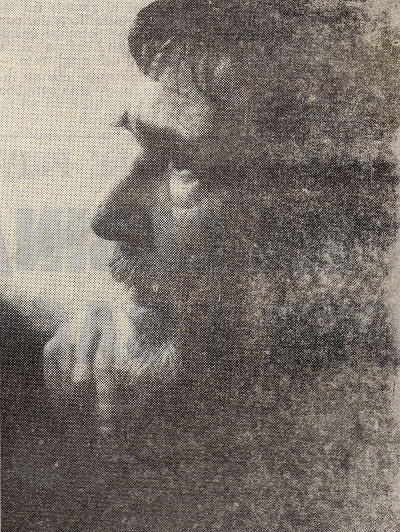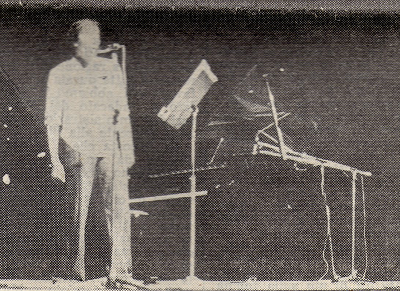Articles:
Let the sounds... be
(from Corriere Mercantile*, July 7 1978, article and photographs by Viana Conti (De Rosa))
(from Corriere Mercantile*, July 7 1978, article and photographs by Viana Conti (De Rosa))
The characteristic trait of John Cage's presence, apart from the oral communication, can be perceived through the ascetic look of his figure. While on one hand he is smiley and willing to dialogue, on the other hand, he is focused and critical in his answers. His mind rigorously filters and sifts the conversation, producing very direct, free and clear definitions. The artist does not appreciate clarifications, or conclusions, but values open and fluent dialogue to find cracks and to create new channels that enable him to constructively invest at any moment during a discussion or a meditation. His words, just like his music, find space within the dialogue and activate a continuity of the creative act. Cage listens to his interlocutor, but anything that he does not agree with gets vehemently rejected. His impetus however, is very amiable.

Caption: John Cage (Corriere Mercantile, Note d'Arte, July 7 1978, photo by Viana Conti (De Rosa))
Cage, endowed with wit and versatility, debunks and demystifies culture's conventional attitudes and positions. The 'instrument' he decides to play, or to prepare with ritualistic manipulation, is dislocated from its institutional location of power and it is transferred to the daily ground of total communication. Cage aims at establishing a direct and continuous contact between nature and society, restoring therefore the state of music before it was polluted by cultural bias, traditions and human emotions. Any sound intention or purpose is put aside.
Music, whose notation contains also a figurative meaning, discovers openings that could not even be imagined by tradition. The artist's gesture is casual, unique, only determined by circumstances. Once the limits of music are stretched, once music is available to anyone and in any form, it becomes a link between the old and young, the misfits and the integrated ones, the sane and the foolish. By means of music, humanity is able to activate and empower its senses. There is no structure in my music
– Cage maintains – and its method lies in wit.
Since his youth, he has been fiddling with disparate subjects: composition, painting, writing, holding conferences, winning prizes, provoking scandals, beginning to practice Zen. After his contatcs with Schönberg, he has been rebuking the tonal system and organizing music according to time, in order to include noises in his work.
During his encounters with Bühlig, this great inventor of inderterminate performances discovered a praxis which translated into the rigorous principle of not repeating a sound before all the others belonging to the same group are played. He learned from the filmmaker Oskar Fischinger the 'music' coming from inanimated objects. To surpass harmony, he turned to percussion. Living room (music) is a 1940 piece where all the instruments that can be found in a living room (newspapers, windows, walls, furniture, books) are employed. In accord with the Indian customs, he expressed the nine fundamental states of emotion. He composed musical collages by means of the casual operations found in the I-Ching.
In the informal, though suspended dimension of reality, Cage allows the obsessive presence of technologic, serial, daily objects. In his impersonal musical processes, he utilizes contact microphones and radios. Music is just a word
- Cage explains - why should we limit it to some specific field? We must make music out of the entire world. Or make a university, like Buckminster Fuller imagined.” And finally: “Discipline is required, to be able to listen. When we listen to more or less organized sounds in a periodic rhythm, we are hearing something different. We are not hearing sounds, but their arrangement. Zen operates a sort of reset and moves towards unorganized sounds, that is, leaving sounds as they are... Music is both pedagogic and present... It's something I would like to call nobility, where noble stands for being free in any instant from love and hatred... If I write music by means of chance operations, it is precisely to free my music from my feelings... Buddhists say that there are sentient and non-sentient beings, depending on them having senses or not. However, we cannot create an hierarchy between listening and not listening. One is not worthier than the other, on the contrary, they both have the same value, an infinite one. My purpose is not to impose on Western people a certain approach, but to persuade them that some sounds exist and these sounds, whatever they may be, deserve to be heard.

Caption: John Cage and Grete Sultan (Corriere Mercantile, Note d'Arte, July 7 1978, photo by Viana Conti (De Rosa))
During the evening of the John Cage performance, on July 4 1978, sponsored by the Teatro dell'Opera of Genoa and hosted in the halls of Teatro Margherita, John Cage prepared the 32 Etudes Australes, a piece completed in 1976, for pianist Grete Sultan. This composition features a number of notes and it is difficult to play as well, because the hands must work independently. Grete, born in Berlin and living in New York since 1942, is a sweet woman that under her apparent fragile body proves to be firm and shows initiative. She studied with Fischer, Arrau, Bühlig and has performed all kinds of materials, from Bach to Schubert, from Beethoven to creative music. As she works and does research with Cage, she is living the total dimension of music.
Paul Zukofsky plays the Freeman Etudes, another recent piece. This young, pale artist is considered in the US the main violin perfomer. He was only 13 years old when he made his debut at Carnagie Hall.

Caption: Demetrio Stratos performing 62 Mesostics Re Merce Cunningham (Corriere Mercantile, Note d'Arte, July 7 1978, photo by Viana Conti (De Rosa))
62 Mesostics Re Merce Cunningham the text presented by Demetrio Stratos, extraordinaire vocal performer, is truncated and shattered into syllables to prevent any possible semantic interpretation. Today a fake supply of insanity exists: the real Insanity
– Stratos insists – is to allow human beings to speak like human beings.
As he explores the limits of his vocals, he is not hoping to return to the language of infants, but reveals elementary structures of language, brief passages, syntactic abstractions.
This instrument – the voice – that Stratos trained and stretched to its limits, delves into sound, channeled in the oral cavities, and detaches it from expressive meanings. It is difficult for the audience to understand the actual complexity of his scores: the most advanced works are not based on sophisticated modulations, but investigate the minimal differences between each phoneme. Thanks to a rational control and a well structured method, the flexibility of the brain impulses is stimulated and improved. Stratos does not aim at organizing his voice, but rather 'breaking' it to discover its cracks. John Cage as author, does not intervene on the performance allowing Stratos to control his own limits. Tension flows from the outside to the inside and generates various outcomes: each text is not static and imprisoned into a formula, but it is open to continuous language explorations.
*Corriere Mercantile, independent newspaper on politics and economics founded in 1824; the article is published inside Note d'Arte, a section curated by Viana Conti, on Friday, July 7, 1978, and opens with the following premise: a series of events and contingencies have dramatized
, so to speak, the meeting between the audience in Genoa and John Cage, the genius composer who invents music and who has been spreading joy and revolution
for over 40 years. After his debated recent adventure on the railroad which featured him preparing and playing a train
and walking through roads and local bands, ballroom dancing orchestras and bell concerts, Cage offered Genoa a famous repertoire, performed by Grete Sultan (piano), Paul Zukofsky (violin) and Demetrio Stratos (voice). The John Cage performance, sponsored by Ente Autonomo del Teatro Comunale dell'Opera di Genova, took place on Tuesday, July 4 at Teatro Margherita
(a big thanks to Viana Conti (De Rosa) for having kindly shared both the article and the photographs)